linguistics
- 格式:ppt
- 大小:376.00 KB
- 文档页数:38
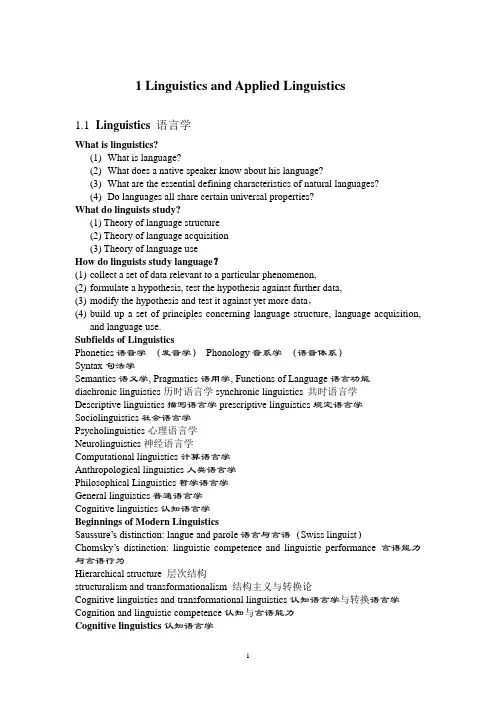
1 Linguistics and Applied Linguistics1.1Linguistics 语言学What is linguistics?(1)What is language?(2)What does a native speaker know about his language?(3)What are the essential defining characteristics of natural languages?(4)Do languages all share certain universal properties?What do linguists study?(1) Theory of language structure(2) Theory of language acquisition(3) Theory of language useHow do linguists study language?(1)collect a set of data relevant to a particular phenomenon,(2)formulate a hypothesis, test the hypothesis against further data,(3)modify the hypothesis and test it against yet more data,(4)build up a set of principles concerning language structure, language acquisition,and language use.Subfields of LinguisticsPhonetics语音学(发音学)Phonology音系学(语音体系)Syntax句法学Semantics语义学, Pragmatics语用学, Functions of Language语言功能diachronic linguistics历时语言学synchronic linguistics共时语言学Descriptive linguistics描写语言学prescriptive linguistics规定语言学Sociolinguistics社会语言学Psycholinguistics心理语言学Neurolinguistics神经语言学Computational linguistics计算语言学Anthropological linguistics人类语言学Philosophical Linguistics哲学语言学General linguistics普通语言学Cognitive linguistics认知语言学Beginnings of Modern LinguisticsSaussure’s distinction: langue and parole语言与言语(Swiss linguist)Chomsky’s distinction: linguistic competence and linguistic performance 言语能力与言语行为Hierarchical structure 层次结构structuralism and transformationalism 结构主义与转换论Cognitive linguistics and transformational linguistics认知语言学与转换语言学Cognition and linguistic competence认知与言语能力Cognitive linguistics认知语言学the experiential view 语言经验观the prominence view 语言突显观the attentional view 语言注意观(1) The bus crashed into the house.(2) The house was hit by the bus.1.2Applied Linguistics应用语言学The problem of the definitionCorder (1973):The application of linguistic knowledge to some object – or applied linguistics, as its name implies –is an activity. It is not a theoretical study. The applied linguist is a consumer, or user, not a producer of theories.(Longman Dictionary of Language Teaching & Applied Linguistics) the study of language and linguistics in relation to practical problems such as lexicography词典编纂, translation, speech pathology言语病理学. Applied linguistics uses information from sociology社会学, psychology心理学, anthropology人类学and information theory as well as from linguistics in order to develop its own theoretical models of language and language use, and then uses this information and theory in practical areas such as syllabus design大纲设计, speech therapy语言障碍矫正, language planning, stylistics文体学.Applied Linguistics as Problem-solvingApplied linguists try to offer solutions to “real-world problems in which language is a central issue” (Brumfit 1991).The responsibility of linguistics, as an academic discipline, is to study language as a system of human communication, build theories of language and offer models, descriptions and explanations of language. The responsibility of applied linguistics is not simply to apply linguistics but to work towards “relevant models” of language description (Widdowson 1980).Applied Linguistics and Foreign Language TeachingThe problem of finding solutions to the problems of language teaching and learningResearchqualitative and quantitative定性研究与定量研究1.3Corpora in Applied Linguistics数据库与应用语言学Corpus(1)For language teaching, corpora can provide information about how a languageworks.(2)Learners can explore corpora for themselves to observe shades of meaning and tomake comparisons between languages.(3)Translators can use comparable corpora to compare translation equivalents in twolanguages.(4)General corpora can be used to establish norms of frequency and usage againstwhich to measure individual texts.(5)Corpora can also be used to investigate cultural attitudes reflected in texts andliterary works as a resource for discourse studies.Types of CorporaSpecialised corpus 特殊数据库General corpus 普通数据库Comparable corpora 比较数据库Parallel corpora 平行数据库Learner corpus 学习者数据库Pedagogic corpus 教学数据库Historical or diachronic corpus 历时数据库Monitor corpus 监察数据库Technical TerminologyType类型Token记号Hapax只用过一次的字句Lemma词目word-form字语形成tag标记符parse解析annotate注释Design and PurposeSizeContentRepresentativenessPermanenceMethods in Processing Corpus InformationProducing concordance linesApplications of Corpora in Applied Linguistics(1)Corpora can be used in writing dictionaries and grammar books for languagelearners.(2)There is a growing concern in Applied Linguistics for the relation betweenlanguage and culture. Language transmits beliefs, attitudes, customs, behaviour, social habits, etc. of the members of a particular society.(3)Translation is an important application of corpora.Corpora and Language TeachingBy studying corpus data, he can answer questions about language himself and discover facts about the language he is learning from authentic examples.Corpus and Syllabus DesignThe syllabus designer collects pieces of authentic language that contain instances of the most frequent patterns of the most frequent words, then the materials writer devises ways of getting the learner involved in exploring the patterning of language in the corpus.Corpora and Learner LanguageA corpus can provide a rich resource for investigating learner language. Corporacomposed of the speech or writing of learners can give information about the difference between learners and between learners and native speakers.。
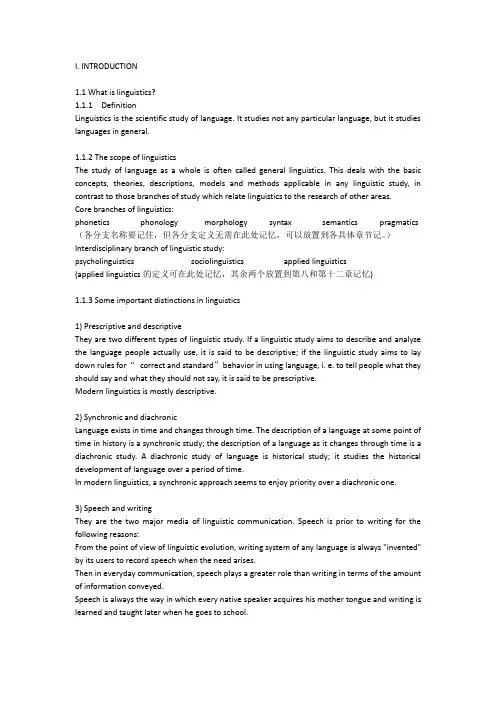
I. INTRODUCTION1.1 What is linguistics?1.1.1 DefinitionLinguistics is the scientific study of language. It studies not any particular language, but it studies languages in general.1.1.2 The scope of linguisticsThe study of language as a whole is often called general linguistics. This deals with the basic concepts, theories, descriptions, models and methods applicable in any linguistic study, in contrast to those branches of study which relate linguistics to the research of other areas.Core branches of linguistics:phonetics phonology morphology syntax semantics pragmatics (各分支名称要记住,但各分支定义无需在此处记忆,可以放置到各具体章节记。
)Interdisciplinary branch of linguistic study:psycholinguistics sociolinguistics applied linguistics(applied linguistics的定义可在此处记忆,其余两个放置到第八和第十二章记忆)1.1.3 Some important distinctions in linguistics1) Prescriptive and descriptiveThey are two different types of linguistic study. If a linguistic study aims to describe and analyze the language people actually use, it is said to be descriptive; if the linguistic study aims to lay down rules for “correct and standard”behavior in using language, i. e. to tell people what they should say and what they should not say, it is said to be prescriptive.Modern linguistics is mostly descriptive.2) Synchronic and diachronicLanguage exists in time and changes through time. The description of a language at some point of time in history is a synchronic study; the description of a language as it changes through time is a diachronic study. A diachronic study of language is historical study; it studies the historical development of language over a period of time.In modern linguistics, a synchronic approach seems to enjoy priority over a diachronic one.3) Speech and writingThey are the two major media of linguistic communication. Speech is prior to writing for the following reasons:From the point of view of linguistic evolution, writing system of any language is always "invented" by its users to record speech when the need arises.Then in everyday communication, speech plays a greater role than writing in terms of the amount of information conveyed.Speech is always the way in which every native speaker acquires his mother tongue and writing is learned and taught later when he goes to school.4) Langue and paroleThe distinction between langue and parole was made by the Swiss linguist F. de Saussure in the early 20th century.Langue refers to the abstract linguistic system shared by all the members of a speech community, and parole refers to the realization of langue in actual use.Langue is the set of conventions and rules which language users all have to abide by. Parole is the concrete use of the conventions and the application of the rules.Langue is abstract; it is not the language people actually. Parole is concrete; it refers to the naturally occurring language events.Langue is relatively stable; it does not change frequently; while parole varies from person to person, and from situation to situation.5) Competence and performanceThe distinction between competence and performance was proposed by the American linguist N. Chomsky in the late 1950’s. Chomsky defines competence as the ideal user’s knowledge of the rules of his language, and performance the actual realization of this knowledge in linguistic communication.Despite the perfect knowledge of his language, a speaker can still make mistakes in actual use due to stess, anxiety or other social and psychological factors.Chomsky thinks that linguistis should study the ideal speaker's competence, not his performance.** Saussure took a sociological view of language and his notion of langue is matter of social conventions, and Chomsky looks at language from a psychological point of veiw and to him competence is a property of the mind of each individual.6) Traditional grammar and modern linguisticsThe beginning of modern linguistics was marked by the publication of F. de Saussure's book "Course in General Linguistics" in the early 20th century.a) Linguistics is descriptive, while traditional grammar is prescriptive.A linguistist is interested in what is said, not in what he thinks ought to be said. He describes language in all its aspects, but does not prescribe rules of "correctness".b) Modern linguistics regards the spoken language as primary, not the written. Traditional grammar tended to emphasize the importance of the written word.c) Modern linguistics does not force language into a Latin-based framework. However, for a long time traditional grammar assumed that Latin provides a universal framework into which all languages fit.1.2 What is language1.2.1 Definition of language?Language is a system of arbitrary vocal symbols used for human communication.First, language is a system, i.e., elements of language are combined according to rules. Second, language is arbitrary in the sense that there is no intrinsic connection between a linguistic symbol and what the symbol stands for.Third, language is vocal because the primary medium for all languages is sound.The term "human" in the definition is meant to specify that language is human-specific, i.e., it is very different from the communication systems other forms of life possess, such as bird songs and bee dances.2.2 Design featuresDesign features refer to the defining properties of human language that distinguish it from any animal system of communication. The framework was proposed by an American linguist, Charles Hockett.1) ArbitrarinessLanguage is arbitrary because there is no logical connection between meanings and sounds. However, we should be aware that while language is arbitrary by nature, it is not entire arbitrary; certain words are motivated.2) ProductivityLanguage is productive in that it makes possible the construction and interpretation of new signals by its users. This is the way they can produce and understand an indefinitely large number of sentences in our native languages, including sentences that we have never heard before.3) DualityLanguage is a system, which consists of two sets of structures, or two levels. At the lower or the basic level there is a structure of sounds, which are meaningless by themselves. But the sounds of language can be grouped and regrouped into a large number of units of meaning, which are found at the higher level of the system.Then the units at the higher level can be arranged and rearranged into an infinite number of sentences.4) DisplacementHuman language can be used to refer to things which are present or not present, real or imagined matters in the past, present, or future, or in far-away places. In other words, language can be used to refer to contexts removed from the immediate situations of the speaker.5) Cultural transmissionThe details of the linguistic system must be learned anew by each speaker. Though the capacity for language in human beings has a genetic basis, the particular language a human being learns is a cultural fact, not a genetic one.1.2.3 Functions of language1. Language is used for communication2. Three main functionsA) Descriptive function (cognitive, referential, or propositional function)--- it is assumed to be the primary function of language. It is the function to convey factual information, which can be asserted or denied, and in some cases even verified.B) Expressive function (emotive or attitudinal function) --- supplies information about the user's feelings, preferences, prejudices and values.C) Social function, also referred to as interpersonal function, serves to establish and maintain social relation between people.3. Function models by structural linguist Roman JakobsonHe identifies six elements of a speech event and relates each one of them to one specific language function.Addresser--- EmotiveThe addresser expresses his attitude to the topic or situation of communication.Addressee--- ConativeThe addresser aims to influence the addressee's course of action or ways of thinking.Context --- ReferentialThe addresser conveys a message or information.Message --- PoeticThe addresser uses language for the sole purpose of displaying the beauty of language itself. Contact --- Phatic communicationThe addresser tries to establish or maintain good interpersonal relationship with the addressee. Code --- MetalinguisticThe addresser uses language to make clear the meaning of language itself.4. Three macrofunctions by M. A. K. HallidayIn the early 1970s the British linguist Halliday found that child language performed seven basic functions and there is close correspondence language between form and function. But as a child grew into an adult the seven functions are gradually replaced by a more abstract, but also simpler system of functions. This system contains three macrofunctions.Ideational function is to organize the speaker or writer's experience of the real or imaginary world. It corresponds closely to the descriptive function discussed above, but it is broader because it also includes the expression of the speaker's attitude, evalution, his feelings and emotions.The interpersonal function is to indicate, establish, or maintain social relationships between people. It expresses the speaker's role in the speech situation, his personal commitment and assessment of the social relationship between the addressee and himself.The textual function is to organize written or spoken texts in such a manner that they are coherent within themselves and fit the particular situation in which they are used.PS:关于Jakobson和Halliday在功能研究方面的详细阐述,建议大家到我校图书馆网页上,找中国期刊网,下载一篇文章:岳颍,“Halliday与Jacoboson的语言功能观比较分析”,《外语艺术教育研究》,2011.6.第2期。

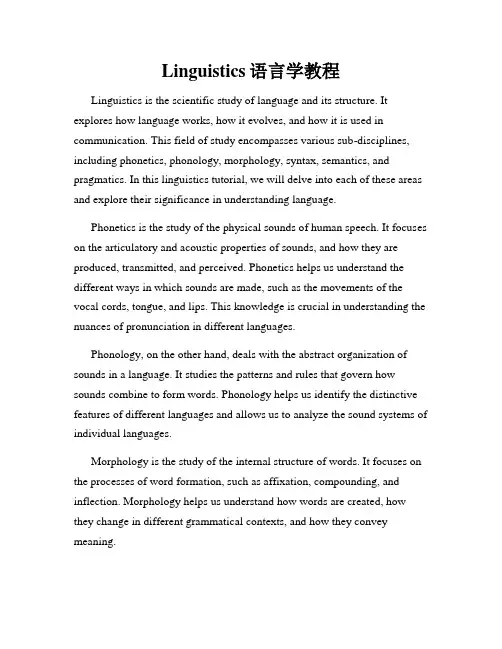
Linguistics语言学教程Linguistics is the scientific study of language and its structure. It explores how language works, how it evolves, and how it is used in communication. This field of study encompasses various sub-disciplines, including phonetics, phonology, morphology, syntax, semantics, and pragmatics. In this linguistics tutorial, we will delve into each of these areas and explore their significance in understanding language.Phonetics is the study of the physical sounds of human speech. It focuses on the articulatory and acoustic properties of sounds, and how they are produced, transmitted, and perceived. Phonetics helps us understand the different ways in which sounds are made, such as the movements of the vocal cords, tongue, and lips. This knowledge is crucial in understanding the nuances of pronunciation in different languages.Phonology, on the other hand, deals with the abstract organization of sounds in a language. It studies the patterns and rules that govern how sounds combine to form words. Phonology helps us identify the distinctive features of different languages and allows us to analyze the sound systems of individual languages.Morphology is the study of the internal structure of words. It focuses on the processes of word formation, such as affixation, compounding, and inflection. Morphology helps us understand how words are created, how they change in different grammatical contexts, and how they convey meaning.Syntax is the study of how words combine to form grammatically correct sentences. It examines the rules and principles that govern sentence structure and word order. Syntax enables us to understand the grammatical structure of sentences and analyze the relationships between words within a sentence.Semantics focuses on the study of meaning in language. It explores how words and sentences convey meaning and how meaning is interpreted by speakers. Semantics helps us understand the nuances of word meanings, the relationships between words, and the various levels of meaning in language.Lastly, pragmatics is the study of how context influences the interpretation of language. It examines how meaning is shaped by the speaker, the listener, and the specific situation in which communication takes place. Pragmatics helps us understand how meaning is inferred from implicit cues, such as tone of voice, gestures, and shared knowledge.Understanding the different sub-disciplines of linguistics is essential in unraveling the complex nature of language. It provides insights into how language is organized, how it is used, and how it evolves over time. Linguistics also has practical applications in fields such as education, translation, and language acquisition.In conclusion, linguistics is a multifaceted field that encompasses the study of various aspects of language. From the physical sounds of speech to the intricate nuances of meaning, linguistics allows us to unravel the mysteries of human communication. By understanding how language works, we gain a deeper appreciation for its complexity and the role it plays in our everyday lives.注意:以上文本仅供参考,不要将其作为最终版本,因为它是通过训练模型生成的,无法保证绝对的准确性和戏剧性。
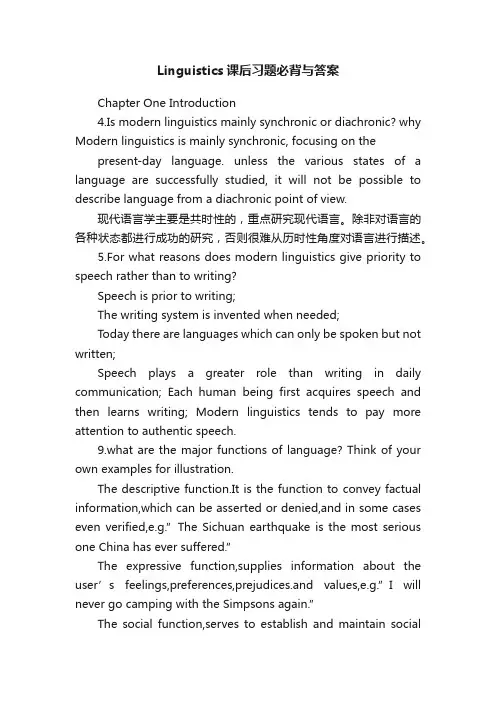
Linguistics课后习题必背与答案Chapter One Introduction4.Is modern linguistics mainly synchronic or diachronic? why Modern linguistics is mainly synchronic, focusing on the present-day language. unless the various states of a language are successfully studied, it will not be possible to describe language from a diachronic point of view.现代语言学主要是共时性的,重点研究现代语言。
除非对语言的各种状态都进行成功的研究,否则很难从历时性角度对语言进行描述。
5.For what reasons does modern linguistics give priority to speech rather than to writing?Speech is prior to writing;The writing system is invented when needed;Today there are languages which can only be spoken but not written;Speech plays a greater role than writing in daily communication; Each human being first acquires speech and then learns writing; Modern linguistics tends to pay more attention to authentic speech.9.what are the major functions of language? Think of your own examples for illustration.The descriptive function.It is the function to convey factual information,which can be asserted or denied,and in some cases even verified,e.g.”The Sichuan earthquake is the most serious one China has ever suffered.”The expressive function,supplies information about the user’s feelings,preferences,prejudices.and values,e.g.”I will never go camping with the Simpsons again.”The social function,serves to establish and maintain socialrelations between people,e.g.”How can I help you, sir?Chapter Two Phonology1.What are the two major media of communication? Of the two, which one is primary and why?Speech and writing are two major media of linguistic communication. Modern linguistics regards speech as the primary one for some reasons. From the point of view of linguistic evolution, speech is prior to writing. The writing system is to record speech. Even today, there are some tribes without writing system. From the view of children’s development, children acquire his mother tongue before they learn to write.5.what criteria are used to classify the English vowels?The criteria used to classify English vowels are:The height of the tongue raising: high, mid, and lowThe position of the highest part of the tongue: front, central, and back The degree of lip rounding: rounded, un-rounded The degree of tenseness/the length of sound: tense (long) or lax (short) The change of sound quality: pure(monophthong), gliding(diphthong)7.How do phonetics and phonology differ in their focus of study? . Phonetics is of a general nature; it is interested in all the speech sounds used in all human languages: how they are produced, how they differ from each other, what phonetic features they possess, how they can be classified, etc.Phonology, on the other hand, aims to discover how speech sounds in a language from patterns and how these sounds are used to convey meaning in linguistic communication.8.What is a phone? How is it different from a phoneme? How are allophones related to the phoneme?A phone is a phonetic unit or segment. The speech soundswe hear and produce during linguistic communication are all phones.A phoneme is a phonological unit; it is a unit that is of distinctive value. It is an abstract unit. It is not any particular sound, but rather it is represented or realized by a certain phone in a certain phonetic context. The different phones which can represent a phoneme in different phoneticenvironments are called the allophones of that phoneme.。
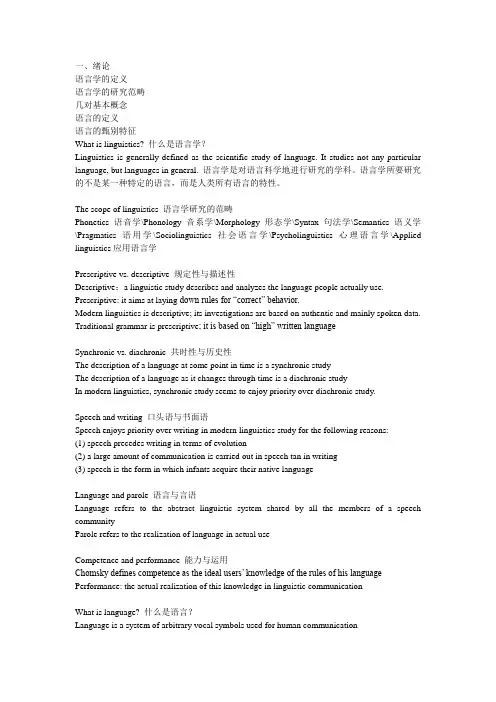
一、绪论语言学的定义语言学的研究范畴几对基本概念语言的定义语言的甄别特征What is linguistics? 什么是语言学?Linguistics is generally defined as the scientific study of language. It studies not any particular language, but languages in general. 语言学是对语言科学地进行研究的学科。
语言学所要研究的不是某一种特定的语言,而是人类所有语言的特性。
The scope of linguistics 语言学研究的范畴Phonetics语音学\Phonology音系学\Morphology形态学\Syntax句法学\Semantics语义学\Pragmatics语用学\Sociolinguistics社会语言学\Psycholinguistics心理语言学\Applied linguistics应用语言学Prescriptive vs. descriptive 规定性与描述性Descriptive:a linguistic study describes and analyzes the language people actually use. Prescriptive: it aims at laying down rules for “correct” behavior.Modern linguistics is descriptive; its investigations are based on authentic and mainly spoken data. Traditional grammar is prescriptive; it is based on “high” written languageSynchronic vs. diachronic 共时性与历史性The description of a language at some point in time is a synchronic studyThe description of a language as it changes through time is a diachronic studyIn modern linguistics, synchronic study seems to enjoy priority over diachronic study.Speech and writing 口头语与书面语Speech enjoys priority over writing in modern linguistics study for the following reasons:(1) speech precedes writing in terms of evolution(2) a large amount of communication is carried out in speech tan in writing(3) speech is the form in which infants acquire their native languageLanguage and parole 语言与言语Language refers to the abstract linguistic system shared by all the members of a speech communityParole refers to the realization of language in actual useCompetence and performance 能力与运用Chomsky defines competence as the ideal users’ knowledge of the rules of his language Performance: the actual realization of this knowledge in linguistic communicationWhat is language? 什么是语言?Language is a system of arbitrary vocal symbols used for human communicationCharacteristics of language: 语言的特性Language is a rule-governed systemLanguage is basically vocalLanguage is arbitrary (the fact different languages have different words for the same object is a good illustration of the arbitrary nature of language. This conventional nature of language is well illustrated by a famous quotation from Shakespeare’s play “Romeo and Juliet”: “A rose by any other name would smell as sweet.”)Language is used for human communicationDesign features of language 语言的甄别特征American linguist Charles Hockett specified 12 design features:1) arbitrariness 武断性2) productivity 创造性3) duality 二重性4) displacement移位性5) cultural transmission 文化传递性二、音系学语言的声音媒介什么是语音学发音器官音标……宽式和严式标音法英语语音的分类音系学和语音学语音、音位、音位变体音位对立、互补分部、最小对立几条音系规则超切分特征Two major media of communication: speech and writingThe limited range of sounds which are meaningful in human communication and are of interest to linguistic studies are the phonic medium of language. 用于人类语言交际的声音称为语音,这些数目有限的一组语音构成了语言的声音媒介。
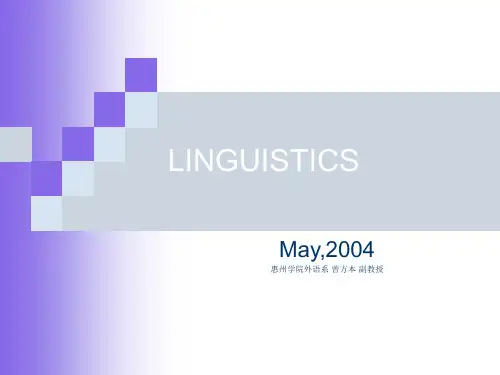
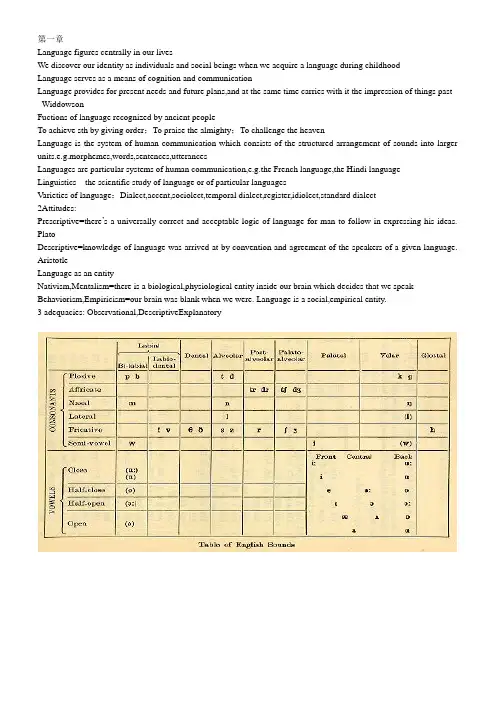
第一章Language figures centrally in our livesWe discover our identity as individuals and social beings when we acquire a language during childhoodLanguage serves as a means of cognition and communicationLanguage provides for present needs and future plans,and at the same time carries with it the impression of things past _WiddowsonFuctions of language recognized by ancient peopleTo achieve sth by giving order;To praise the almighty;To challenge the heavenLanguage is the system of human communication which consists of the structured arrangement of sounds into larger units.e.g.morphemes,words,sentences,utterancesLanguages are particular systems of human communication,e.g.the French language,the Hindi languageLinguistics---the scientific study of language or of particular languagesV arieties of language:Dialect,accent,sociolect,temporal dialect,register,idiolect,standard dialect2Attitudes:Prescriptive=there’s a universally correct and acceptable logic of language for man to follow in expressing his ideas. PlatoDescriptive=knowledge of language was arrived at by convention and agreement of the speakers of a given language. AristotleLanguage as an entityNativism,Mentalism=there is a biological,physiological entity inside our brain which decides that we speak Behaviorism,Empiricism=our brain was blank when we were. Language is a social,empirical entity.3 adequacies: Observational,DescriptiveExplanatoryThe principal organs of articulation第三章Micro-Applied linguistics=the study of second and foreign language learning and teachingPhonetics is the science of speech sounds, which aims to provide the set of features or properties that can be used to describe and distinguish all the sounds used in human语音学Phonetics is divided into 3 sub-fields:发音语音学Articulatory phonetics studies speech production by the speech organs;声学语音学Acoustic phonetics studies physical properties of speech sounds;听觉语音学Auditory phonetics studies the perception of speech sounds in the human auditory and cognitive system. Phoneme: the smallest unit of sound in a language which can distinguish meaning (or two words).两类•Free morphemes: those which can occur on their own as separate words, e.g.luck•Bound morphemes: those which cannot occur on their own as separate w ords, e.g.-y ◊ lucky; -s ◊ books; re- ◊retellAllophones:allophones in complementary distribution;allophones in free variation.音位变体,互补,自由。
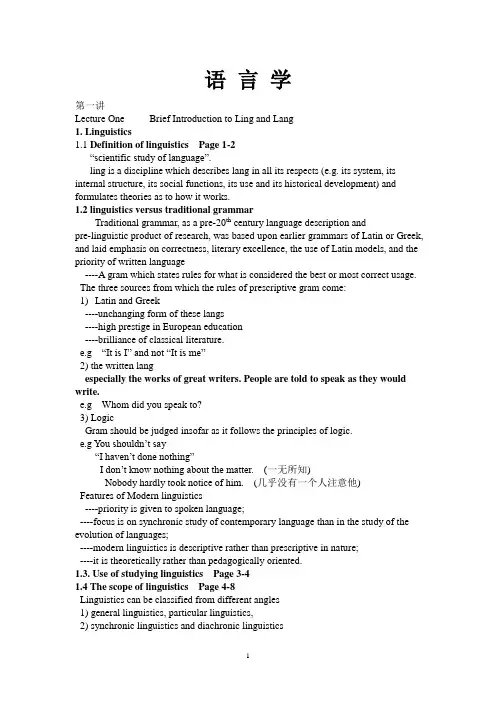
语言学第一讲Lecture One Brief Introduction to Ling and Lang1. Linguistics1.1 Definition of linguistics Page 1-2“scientific study of language”.ling is a discipline which describes lang in all its respects (e.g. its system, its internal structure, its social functions, its use and its historical development) and formulates theories as to how it works.1.2linguistics versus traditional grammarTraditional grammar, as a pre-20th century language description andpre-linguistic product of research, was based upon earlier grammars of Latin or Greek, and laid emphasis on correctness, literary excellence, the use of Latin models, and the priority of written language----A gram which states rules for what is considered the best or most correct usage. The three sources from which the rules of prescriptive gram come:1)Latin and Greek----unchanging form of these langs----high prestige in European education----brilliance of classical literature.e.g “It is I” and not “It is me”2) the written langespecially the works of great writers. People are told to speak as they would write.e.g Whom did you speak to?3) LogicGram should be judged insofar as it follows the principles of logic.e.g You shouldn’t say“I haven’t done nothing”I don’t know nothing about the matter. (一无所知)Nobody hardly took notice of him. (几乎没有一个人注意他)Features of Modern linguistics----priority is given to spoken language;----focus is on synchronic study of contemporary language than in the study of the evolution of languages;----modern linguistics is descriptive rather than prescriptive in nature;----it is theoretically rather than pedagogically oriented.1.3. Use of studying linguistics Page 3-41.4 The scope of linguistics Page 4-8Linguistics can be classified from different angles1) general linguistics, particular linguistics,2) synchronic linguistics and diachronic linguistics3) comparative-historical linguistics and contrastive linguistics4) theoretical linguistics, applied linguistics (the structure/system)5) prescriptive ling, descriptive ling6) microlinguistics and macrolinguisticsMicrolinguistics:Phonetics ----Phonology---Morphology--Syntax---Semantics---PragmaticsMacrolinguistics:Sociolinguistics—Psycholinguistics—Neurolinguistics—Anthropological linguistics---Applied linguistics---Corpus linguistics----Discourse Analysis----Cognitive linguistics----Computational linguistics----. ExerciseComment on the differences between human language and animal communication, and provide examples if you can.第二讲differences between human language and animal communication:1) language has the ability to refer to things far removed in time and space. Human frequently say things such as “My uncle went to Shanghai last week.”. In contrast, it may be impossible for an animal to convey similar information.2) humans have the ability to produce and understand an indefinite number of novel utterances, but no animal can communicate creatively with another animal.3) learning/acquiring is much more important as a factor in human language than in animal communication.4) Human language structure and language use are vastly more complex than any known animal communication system.5) animal communication systems are closed, whereas human languages are open-ended.6) humans can perform acts with language.2. Language2.1 Definition of language (Page 8)Tool for human communicationMeans by which we express our feeling…..Comprehensive definitionIt is really just as difficult to define language as it is to define man.人:是一切社会关系的总和;是唯一能把动物养成宠物和煮成食物的动物;是一种会笑的动物;"Language is a system of arbitrary vocal symbols used for human communication"Wardhaugh in his "Introduction to Linguistics" (1972).(语言是用于人类交际的、任意的、有声的符号系统)Short as it is, this definition has captured the main features of language.First of all, language is a system.Second, language is arbitrary.Third, language is vocal.Fourth, language is symbolic.Fifth, language is used for human communication and language ishuman-specific.2.2 Origine of language (page3-4)In general, there are two contrasting viewpoints: the divinist and evolutionist The divinists---- ----language was God’s gift to mankindAccording to Christian beliefs, God gave Adam the power to name all things. Whatever Adam called everything God created. Language is the creation of God. Evolutionists----language is the product of human evolution. It was originated in the process of labor.According to the evolution theory proposed by Darwin, language is a product of evolutionary development of the human species. It is a human invention.The earliest human being is believed to live in Africa around 200,000 years ago, and modern language emerged perhaps around 100,000 years ago (Aitchison, 1996). In the beginning there was one language developed by Afican men. As these ancient ancestors walked out of Afica and spread around the world about 35, 000 to 12, 000 years ago, more and more languages were developed.2.3 Design Features of Language1) Arbitrariness---There is no logical (intrinsic or direct) connection between the sound/sign and meaning, between the word and its object, between the grammar and the meaning it carries;or the forms of linguistic signs bear no natural relationship to their meaning.A building we live in with our family is called house in English, maison in French, dom in Russion, casa in Spanish, fangzi in ChineseHowever, language is not entirely arbitrary; there are cases where there seems to be some association between sounds and meaning, e.g.Onomatopoetic words: P10Motivated wordsSome compound words: tractor driver shoe-makerThe other side of the coin of arbitrariness is conventionality. The link between linguistic sign and its meaning is a matter of convention.A pair of trousers----一条裤子 A pair of shirts---两件衬衣Go shopping *go buying go hunting冬瓜(white gourd) (夏天吃的)北戴河is not a river 中南海is not a sea.食堂餐厅*餐堂*食厅英国的语言----英语英文中国的语言----中文(*中语)汉语昨天昨晚*昨早*昨月*昨年去年*去天*去晚*去月明天明年*明月*明周今天今年*今月两百二十元----*二百两十元二百五----傻里傻气的人生前好友(死前好友)已婚夫妇未婚妻(未婚怎么能称妻)三长两短、七上八下三下五除二2) DualityTwo levels:Lower level---- a limited set of sounds, meaninglessHigher level----units of meaning coming from the combination of the units of lower level Phoneme—morpheme—words—phrase—clause—sentence3) Productivity/creativity--The users of a language can utilize limited linguistic rules to produce or understand infinite meaningful linguistic forms, including those they have never heard before.This is the cat that killed the rat that ate the malt that lay in the house that Jack built.The man that the girl that my wife taught married published many poems.(和我妻子教的那个女孩结婚的那个男人发表了许多诗)他一边脱衣服,一边穿裤子。
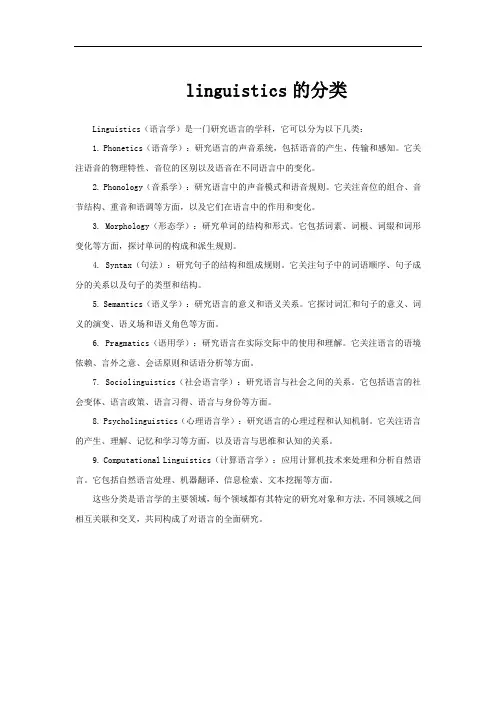
linguistics的分类Linguistics(语言学)是一门研究语言的学科,它可以分为以下几类:1. Phonetics(语音学):研究语言的声音系统,包括语音的产生、传输和感知。
它关注语音的物理特性、音位的区别以及语音在不同语言中的变化。
2. Phonology(音系学):研究语言中的声音模式和语音规则。
它关注音位的组合、音节结构、重音和语调等方面,以及它们在语言中的作用和变化。
3. Morphology(形态学):研究单词的结构和形式。
它包括词素、词根、词缀和词形变化等方面,探讨单词的构成和派生规则。
4. Syntax(句法):研究句子的结构和组成规则。
它关注句子中的词语顺序、句子成分的关系以及句子的类型和结构。
5. Semantics(语义学):研究语言的意义和语义关系。
它探讨词汇和句子的意义、词义的演变、语义场和语义角色等方面。
6. Pragmatics(语用学):研究语言在实际交际中的使用和理解。
它关注语言的语境依赖、言外之意、会话原则和话语分析等方面。
7. Sociolinguistics(社会语言学):研究语言与社会之间的关系。
它包括语言的社会变体、语言政策、语言习得、语言与身份等方面。
8. Psycholinguistics(心理语言学):研究语言的心理过程和认知机制。
它关注语言的产生、理解、记忆和学习等方面,以及语言与思维和认知的关系。
9. Computational Linguistics(计算语言学):应用计算机技术来处理和分析自然语言。
它包括自然语言处理、机器翻译、信息检索、文本挖掘等方面。
这些分类是语言学的主要领域,每个领域都有其特定的研究对象和方法。
不同领域之间相互关联和交叉,共同构成了对语言的全面研究。
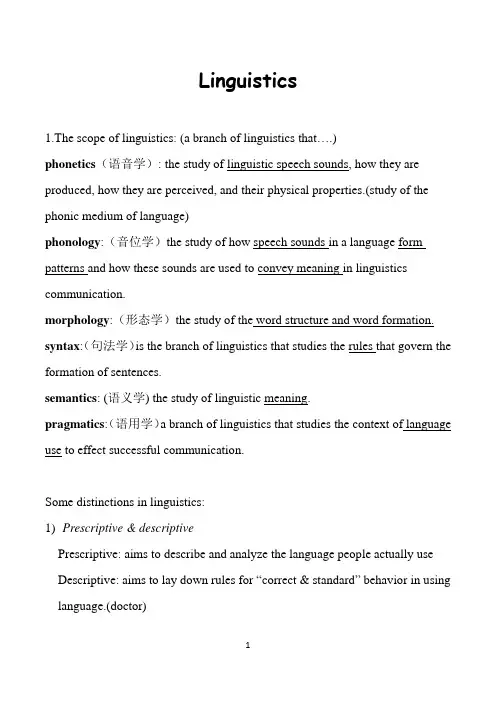
Linguistics1.The scope of linguistics: (a branch of linguistics that….)phonetics(语音学): the study of linguistic speech sounds, how they are produced, how they are perceived, and their physical properties.(study of the phonic medium of language)phonology:(音位学)the study of how speech sounds in a language form patterns and how these sounds are used to convey meaning in linguistics communication.morphology:(形态学)the study of the word structure and word formation. syntax:(句法学)is the branch of linguistics that studies the rules that govern the formation of sentences.semantics: (语义学) the study of linguistic meaning.pragmatics:(语用学)a branch of linguistics that studies the context of language use to effect successful communication.Some distinctions in linguistics:1)Prescriptive & descriptivePrescriptive: aims to describe and analyze the language people actually use Descriptive: aims to lay down rules for “correct & standard” behavior in using language.(doctor)2)Synchronic & diachronic 共时的&历时的Synchronic: the description of a language at some point of time in history.Diachronic: the description of a language as it changes through time.3)Langue & parole 语言&言语Langue: refers to the abstract linguistic system shared by all the members ofa speech community.Parole: refers to the realization of language in actual use.4)Competence & performance 语言能力&语言运用Competence: the ideal user’s knowledge of the rules of his languagePerformance: the actual realization of this knowledge in linguisticcommunication.Design features of language:1)arbitrariness: (任意性)means there is no logical connection betweenmeanings and sounds.2)Productivity: it makes possible the construction and interpretation of newsignals by its users.3)Duality:(双重性)duality of structure or double articulation of languageenables users to talk about anything within their knowledge.4)Displacement: language can be used to refer to contexts removed from theimmediate situations of the speaker. 不受时空限制5)Cultural transmission 文化传播(eg:狼孩)2.Functions of language:1)Descriptive function: it is the function to convey factual information,which can be asserted or denied, and in some cases even verified.2)Expressive function: supplies information about the user’s feelings,preferences, prejudices and values.3)Social function: serves to establish and maintain social relations betweenpeople.Phone:(音素)is a phonetic unit or segment.Phoneme:(音位)is a phonological unit. It is a unit that is of distinctive value. It is an abstract unit.3.Morphemes词素—the minimal units of meaningThe smallest unit of language that carries information about meaning or function Free morpheme: a morpheme which can be a word by itself.Bound morpheme: a morpheme must be attached to another one.Derivational morphemes:(衍生词素) the morphemes which change the category or grammatical class of words. They are conjoined to other morphemes /words, new words are derived or formed. (-en,-ate,-ic,-ous,-ly,-tion,-sive,-er) 标出Inflectional morphemes: (曲折词素) they are attached to words or morphemes, but they never change their syntactic category.(-s,-er,-est,-ed,-ing) ○标出4.Category: refers to a group of linguistic items which fulfill the same or similar functions in a particular language such as a sentence, a noun phase or a verb. Non-traditional categories: determiner(Det)限定词,degree(Deg),qualifier(Qua) Phrase elements : specifiers, complements(XP Rule), modifiers.Deep structure: formed by the XP rule in accordance with the head’s subcategorization properties. 没变形陈述句Surface structure5. Lexical meaning:Sense: is concerned with the inherent meaning of a linguistic form, the collection of all its features; it is abstract and de-contextualized.Eg: dog-general meaning of dog, featuresReference: means what a linguistic form refers to in the real, physical world. Eg;One particular/certain dog existent in the situation, known to each other6.Context: it is generally considered as constituted by the knowledge shared by the speaker and the hearer. (John Firth)Speech act theory: (John Austin)Locutionary act:(言内行为)is the act of uttering words, phrases and clauses. Illocutionary act: (言外之意) is the act of expressing the speaker’s intention; it is the act of performed in saying something.Perlocutionary act:(言后行为)is the act of performed by or resulting from saying something; it is the consequence of, or the change brought about by the utterance.Cooperative principle-CP (Paul Grice)The maxim of quantity:Say no less than the conversation requires.Say no more than the conversation requires.The maxim of quality:Don't say what you believe to be false.Don't say things for which you lack evidence.The maxim of manner:Don't be obscure. Don't be ambiguous.Be brief. Be orderly.The maxim of relevance: Be relevant.7. Language changeAddition of new words:1)Coinage:创新词Spyware digital camera cyber citizen mouse potato2)Clipped words: 缩略词Lab-laboratory gym-gymnasium fridge-refrigerator burger-hamburger 3)Blending: 紧缩法Smog-smoke+fog brunch-breakfast+lunch camcorder-camera+recorder 4)Acronyms: 首字母缩略词CEO-chief executive officer IT-information technologyEU VIP B2B CPI5)Back-formation: 逆构词法To edit/beg/baby-sit/donate/orient/hawk/aviate/appreciate6)Function shiftn.-v. To knee/bug/tape v.-n. a hold/reject/retreatadj.-v. to cool/narrow/dim/slow7)BorrowingBonus tragedy skirt education cycle prince guitar balconyBalloon opera pump tea tofu kowtow sampan zeroKungfu mahjong spaghetti bizarre garage8)Derivation 派生词Fixable refusal exciting impressive dislike restateanti-pollution unfair realize happiness9)Compounds 复合词Bittersweet rainbow spoonfeed sleepwalk inborn off-licenseUndertake without landlady handover whitewash8.Register 语域Field of discourse话语范围: refers to what is going on: on the area of operation of the language activity.Tenor of discourse话语基调: refers to the role of relationship in the situation in question: who the participants in the communication groups are and what relationship they stand to each other.Mode of discourse话语方式: refers to the means of communication. It is concerned with “how” communication is carried out.9.Sapir-whorf hypothesis (SWH) 萨丕尔·沃尔夫假说Language filters people’s perception ang the way they categorize their experiences.10. Language AcquisitionTheories of child language acquisition:1)The behavioristImitation and practice are preliminary, and discrimination and generalization are crucial to language development.(habit-forming)But it fails to explain how children acquire more complex grammaticalstructures of the language.2)The innatistLanguage Acquisition device(LAD)ChomskyIt proposed that human beings are born with an innate ability.It said that the “the black box” contain principles that are universal to all human language.Universal Grammar (UG)3)The interactionistIt holds that language develops as a result of the complex interplay between the human characteristics of the child and the environment in which he grows.motherese child directed speech (CDS) caretaker talkCritical Period Hypothesis (CPH) Eric LennebergLAD works successfully only when it is stimulated at the right time—aspecific and limited time period for language acquisition.Two versions:Strong one suggests that children must acquire their first language by puberty or they will never be able to learn from subsequent exposure.The weak holds that language learning will be more difficult and incomplete after puberty.11. Second Language AcquisitionPositive transfer正迁移facilitateNegative transfer 负迁移interfere or hinderInterlanguage 中介语It was established as learners’ independent system of the second language, which is of neither the native language nor the second language, but a continuum or approximation from one extreme of his native language to the other of the second language.Fossilization 石化现象It is a process occurring from time to time in which incorrect linguistic features become a permanent part of the way a person speaks or writes a language.Acquisition 习得It is a subconscious process without minute learning of grammatical rules. Learning学习It refers to conscious efforts to learn the second language knowledge by learning the rules and talking about the rules.。
Linguistics: The Science of LanguageLinguistics is the scientific study of language, its structure, development, and variation. It is a diverse field that encompasses many sub-disciplines, each exploring different aspects of language. Linguistics combines the analytical power of the scientific method with the rich complexity of human communication.The field of linguistics has its roots in the 16th century when European scholars began to systematically study language. However, the idea that language is deserving of a scientific study is much older. The ancient Greeks, for example, developed a theory of language that attempted to explain the origin and structure of Homer's epics.Over the centuries, linguistics has grown and developed into a wide-ranging field. Today, linguists investigate the structure and function of languages across the globe, studying topics such as phonetics, morphology, syntax, semantics, and sociolinguistics.Phonetics is the study of the sounds of language and how they are produced. Morphology is the study of word structure, including word formation and inflection. Syntax is concerned with the structure of sentences, exploring how words combineto form grammatically correct sentences. Semantics focuses on the meaning of words and how they are combined to create meaningful messages. Sociolinguistics examines how language is used in social contexts and how it varies across different social groups.In addition to these sub-disciplines, computational linguistics explores the intersection of language and computers, paving the way for advances in machine translation, speech recognition, and natural language processing. Applied linguistics focuses on using knowledge about language in practical applications, such as second language acquisition, language teaching, and cross-cultural communication.The importance of linguistics cannot be overstated. Language is central to human experience, serving as the primary means of communication and expression. Understanding language allows us to comprehend how people think, express ideas, and share experiences. Linguistics also informs our understanding of human cognition and social organization. It provides insights into how languages change over time and how they are transmitted across generations.Moreover, linguistics has practical applications in areas such as education, communication disorders, translation andinterpretation, and language policy. Language teachers use insights from linguistics to inform their teaching practices, helping students learn new languages more effectively. Speech pathologists rely on linguistic knowledge to diagnose and treat communication disorders. Translators and interpreters use linguistic expertise to convey messages accurately across languages. And language policymakers draw on linguistic research to inform decisions about language education and official language policies.In conclusion, linguistics is a vibrant and multifaceted field that offers valuable insights into the nature of human communication. It contributes to our understanding of how language works, how it varies across different languages and cultures, and how it shapes our worldview. The field of linguistics continues to grow and evolve as new technologies and methods are developed, revealing more about the complexities of human language.。
linguistics练习题一、语音学与音系学2. 描述元音和辅音的分类方法。
3. 解释音素与音位之间的区别。
4. 举例说明音位变体。
6. 识别并标注下列句子中的音素:The quick brown fox jumps over the lazy dog.8. 描述声母和韵母的概念。
9. 分析英语中的元音和谐现象。
10. 解释语音学与音系学的区别与联系。
二、形态学与词汇学12. 举例说明词根和词缀的作用。
15. 描述英语中的名词、动词和形容词的屈折变化。
16. 解释形态学与词汇学的关系。
18. 举例说明词义扩大、词义缩小和词义转移。
19. 解释词义与语境的关系。
20. 描述英语中的词义分类。
三、句法学24. 描述英语中的主谓一致规则。
25. 解释并列句与复合句的区别。
27. 描述英语中的被动语态结构。
29. 解释句子类型:简单句、并列句、复合句。
30. 描述英语中的疑问句、否定句和祈使句的结构。
四、语义学与语用学33. 解释语义学与语用学的区别与联系。
34. 描述英语中的情态动词及其意义。
36. 解释语境对句子意义的影响。
38. 描述英语中的礼貌用语及其功能。
39. 解释隐喻和转喻的概念。
五、语言习得与语言学应用41. 描述儿童语言习得的过程。
42. 解释二语习得与母语习得的差异。
44. 描述语言教学中的交际法、任务型教学法等。
45. 解释语言测试的类型及其功能。
47. 描述跨文化交际中的语言障碍。
48. 解释语言规划与语言政策的概念。
50. 描述语言与认知、情感、社会等因素的关系。
六、历史语言学51. 描述语言变化的主要类型及其原因。
52. 解释语言演化的连续性与非连续性。
53. 分析英语历史上的重大语言变革。
54. 识别并解释古英语与现代英语之间的差异。
55. 描述语言学中的比较法及其在历史语言学中的应用。
56. 解释历史语言学与历时语言学的区别。
58. 描述语言接触对语言变化的影响。
59. 解释语言死亡的概念及其原因。
1。
3 语言的结构特征我们能达成共识的是语言对于人类来说是必不可少的,然而我的发现,对什么使得人类语言比动物“语言”更具优越性的问题却难以进行确定。
为了在其群体中进行交配、繁殖与合作,象鸟和·蜜蜂这些物种通过唱歌或跳舞也能进行交际的,这些歌舞同样也遵循着非常复杂的惯例。
它们也在使用语言吗?并非如此。
正如伯特兰·罗素曾经说到的那样:“不管一只狗叫得多么动人,但它不能告诉你,其父母家境贫寒,但却诚实有加。
”那么,是什么使得人·类语言如此复杂灵活、如此不受即时语境所制约,并且如此善长刁:创造新意义呢,简言之,如此与其他物种所使用语言不同呢?这些定义我们人类语言的特征被称为结构特征。
下面是一些经常论及的语言结构特征。
1.3.1 任意性这种由索诸尔论及的被广泛接受的特征最先是指语言符号形式与其意义之间不存在着任何自然关系。
譬如,我们无法解释为3什么book(书)被称为/buk/,pen(笔)被称为/pen/。
然而,任意性好象也存在于不同的层面。
(1)词素的语音与其意义之间的任意性关系当你想起不同程度的拟声词,即听起来就象其浯音所描述的词汇,如汉语词,叮咚、轰隆、叽哩咕噜时,你可能会表示反对。
这些语言形式似乎有一种自然根据。
但在英语里,却是采用截然不同的词来描述该语音。
例如,英语里的狗叫声为WOWWOW,而汉语里狗叫声却是wang-wangwang。
然而,在拟声效果方面却存在着某些误解。
事实上,任意性与拟声效果可能会同时起作用。
譬如,威多逊引用了济慈的《夜莺颂》中一行诗来进行例证:例l—1The murmurous haunt Of fliesOn summer eves.假如你大声朗读的话,你可能会感受到语音与其意义之间的联系。
但此种效果并非是真正源自于那些沙沙声本身,因为在建立这种联系之前你得先了解murmurous(沙沙声),summer(夏日),eves(傍晚)等词的意义。
Linguistics语言学,the study of human language。
包括Theoretical linguistics,Applied linguistics,Sociolinguistics,Cognitive linguistics和Historical linguistics。
这里主要考Theoretical linguistics,包括:1.Lexis词汇学, the study of what is a word and where words come from2.Semantics语义学,the study of meaning in a language3.Phonetics语音学,the study of speech sounds (voice).4.Phonology音位学/音系学,the study of how sounds are put together and used to convey meaning in communication5.Morphology形态学,the study of the structure and form of words and phrases6.Syntax句法学,the study of the rules, or "patterned relations" that govern the way the words in a sentence come together,与morphology形态学并称grammer语法学7.Stylistics文体学,the study of style used in literary, and verbal language and the effect the writer/speaker wishes to communicate to the reader/hearer.8.Pragmatics语用学,generally the study of natural language understanding, and specifically the study of how context influences the interpretation of meanings.补充:general linguistics, the study of the structure and development of language in generalChapter 1 IntroductionⅠ. Decide whether each of the following statements is True or False:1. Linguistics is generally defined as the scientific study of language. T2. Linguistics studies particular language, not languages in general. F3. A scientific study of language is based on what the linguist thinks. F4. In the study of linguistics, hypotheses formed should be based on language facts and checked against the observed facts. T5. General linguistics is generally the study of language as a whole. T6. General linguistics, which relates itself to the research of other areas, studies the basic concepts, theories, descriptions, models and methods applicable in any linguistic study. T7. Phonetics is different from phonology in that the latter studies the combinations of the sounds to convey meaning in communication. T8. Morphology studies how words can be formed to produce meaningful sentences. F9. The study of the ways in which morphemes can be combined to form words is called morphology. T10. Syntax is different from morphology in that the former not only studies the morphemes, but also the combination of morphemes into words and words into sentences. T11. The study of meaning in language is known as semantics. T12. Both semantics and pragmatics study meanings. T13. Pragmatics is different from semantics in that pragmatics studies meaning not in isolation, but in context. T14. Social changes can often bring about language changes. T15. Sociolinguistics is the study of language in relation to society. T16. Modern linguistics is mostly prescriptive, but sometimes descriptive. T17. Modern linguistics is different from traditional grammar.18. A diachronic study of language is the description of language at some point in time. T19. Modern linguistics regards the written language as primary, not the written language.20. The distinction between competence and performance was proposed by F. de Saussure. FⅡ. Fill in each of the following blanks with one word which begins with the letter given:21. Chomsky defines “competence” as the ideal user’s k__________ of the rules of his language.22. Langue refers to the a__________ linguistic system shared by all the members of a speech community while the parole is the concrete use of the conventions and application of the rules.23. D_________ is one of the design features of human language which refers to the phenomenon that language consists of two levels: a lower level of meaningless individual sounds and a higher level of meaningful units.24. Language is a system of a_________ vocal symbols used for human communication.25. The discipline that studies the rules governing the formation of words into permissible sentences in languages is called s________.26. Human capacity for language has a g_______ basis, but the details of language have to be taught and learned.27. P _______ refers to the realization of langue in actual use.28. Findings in linguistic studies can often be applied to the settlement of some practical problems. The study of such applications is generally known as a________ linguistics.29. Language is p___________ in that it makes possible the construction and interpretation of new signals by its users. In other words, they can produce and understand an infinitely large number of sentences which they have never heard before.30. Linguistics is generally defined as the s _______ study of language.Ⅲ. There are four choices following each statement. Mark the choice that can best complete the statement:31. If a linguistic study describes and analyzes the language people actually use, it is said to be _______.A. prescriptiveB. analyticC. descriptiveD. linguistic32. Which of the following is not a design feature of human language?A. ArbitrarinessB. DisplacementC. DualityD. Meaningfulness33. Modern linguistics regards the written language as _______.A. primaryB. correctC. secondaryD. stable34. In modern linguistics, speech is regarded as more basic than writing, because _______.A. in linguistic evolution, speech is prior to writingB. speech plays a greater role than writing in terms of the amount of information conveyedC. speech is always the way in which every native speaker acquires his mother tongueD. All of the above35. A historical study of language is a _______ study of language.A. synchronicB. diachronicC. prescriptiveD. comparative36. Saussure took a(n) _______ view of language, while Chomsky looks at language from a ________ point of view.A. sociological…psychologicalB. psychological…sociologicalC. applied…pragmaticD.semantic…linguistic37. According to F. de Saussure, _______ refers to the abstract linguistic system shared by all the mem- bers of a speech community.A. paroleB. performanceC. langueD. Language38. Language is said to be arbitrary because there is no logical connection between _______ and meanings.A. senseB. soundsC. objectsD. ideas39. Language can be used to refer to contexts removed from the immediate situations of the speaker. This feature is called _______,A. displacementB. dualityC. flexibilityD. cultural transmission40. The details of any language system is passed on from one generation to the next through _______, rather than by instinct.A. learningB. teachingC. booksD. both A and BⅣ. Define the following terms:41. Linguistics42. Phonology43. Syntax44. Pragmatics45. Psycholinguistics46. Language47. Phonetics48. Morphology49. Semantics50. Sociolinguistics51. Applied Linguistics52. Arbitrariness53. Productivity54. Displacement55. Duality56. Design Features57. Competence58. Performance59. Langue60. ParoleⅤ. Answer the following questions as comprehensively as possible. Give examples for illustration if necessary:61. Language is generally defined as a system of arbitrary vocal symbols used for human commu- nication. Explain it in detail.62. What are the design features of human language? Illustrate them with examples.63. How is modern linguistics different from traditional grammar?64. How do you understand the distinction between a synchronic study and a diachronic study?65. Why does modern linguistics regard the spoken form of language as primary, not the written?66. What are the major distinctions between langue and parole?67. How do you understand competence and performance?68. Saussure’s distinction between langue and parole seems similar to Chomsky’s distinction between competence and performance. What do you think are their major differences?69. Do you think human language is entirely arbitrary? Why?Chapter 2 PhonologyⅠ. Decide whether each of the following statements is True or False:1. Voicing is a phonological feature that distinguishes meaning in both Chinese and English.2. If two phonetically similar sounds occur in the same environments and they distinguish meaning, they are said to be in complementary distribution.3. A phone is a phonetic unit that distinguishes meaning.4. English is a tone language while Chinese is not.5. In linguistic evolution, speech is prior to writing.6. In everyday communication, speech plays a greater role than writing in terms of the amount of information conveyed.7. Articulatory phonetics tries to describe the physical properties of the stream of sounds which a speaker issues with the help of a machine called spectrograph.8. The articulatory apparatus of a human being are contained in three important areas: the throat, the mouth and the chest.9. Vibration of the vocal cords results in a quality of speech sounds called voicing.10. English consonants can be classified in terms of place of articulation and the part of the tongue that is raised the highest.11. According to the manner of articulation, some of the types into which the consonants can be classified are stops, fricatives, bilabial and alveolar.12. Vowel sounds can be differentiated by a number of factors: the position of tongue in the mouth, the openness of the mouth, the shape of the lips, and the length of the vowels.13. According to the shape of the lips, vowels can be classified into close vowels, semi-close vowels, semi-open vowels and open vowels.14. Any sound produced by a human being is a phoneme.15. Phones are the sounds that can distinguish meaning.16. Phonology is concerned with how the sounds can be classified into different categories.17. A basic way to determine the phonemes of a language is to see if substituting one sound for another results in a change of meaning.18. When two different forms are identical in every way except for one sound segment which occurs in the same place in the strings, the two words are said to form a phonemic contrast.19. The rules governing the phonological patterning are language specific.20. Distinctive features of sound segments can be found running over a sequence of two or more phonemic segments.Ⅱ. Fill in each of the following blanks with one word which begins with the letter given:21. A_______ refers to a strong puff of air stream in the production of speech sounds.22. A_______ phonetics describes the way our speech organs work to produce the speech sounds and how they differ.23. The four sounds /p/, /b/, /m/ and /w/ have one feature in common, i.e., they are all b_______ sounds.24. Of all the speech organs, the t_______ is the most flexible, and is responsible for varieties of articulation than any other.25. English consonants can be classified in terms of manner of articulation or in terms of p_______ of articulation.26. When the obstruction created by the speech organs is total or complete, the speech sound produced with the obstruction audibly released and the air passing out again is called a s________.27. S_________ features are the phonemic features that occur above the level of the segments. They include stress, tone, intonation, etc.28. The rules that govern the combination of sounds in a particular language are called s_______ rules.29. The transcription of speech sounds with letter-symbols only is called broad transcription while the transcription with letter-symbols together with the diacritics is called n_________ transcription.30. When pitch, stress and sound length are tied to the sentence rather than the word in isolation, they arecollectively known as i_________.31. P___________ is a discipline which studies the system of sounds of a particular language and how sounds are combined into meaningful units to effect linguistic communication.32. The articulatory apparatus of a human being are contained in three important cavities: the pharyngeal cavity, the o_______ cavity and the nasal cavity.33. T_______ are pitch variations, which are caused by the differing rates of vibration of the vocal cords and which can distinguish meaning just like phonemes.34. Depending on the context in which stress is considered, there are two kinds of stress: word stress and s_________ stress.Ⅲ. There are four choices following each statement. Mark the choice that can best complete the statement:35 Of all the speech organs, the _______ is/are the most flexible.A. mouthB. lipsC. tongueD. vocal cords36. The sounds produced without the vocal cords vibrating are ____ sounds.A. voicelessB. voicedC. vowelD. consonantal37. __________ is a voiced alveolar stop.A. /z/B. /d/C. /k/D. /b/38. The assimilation rule assimilates one sound to another by “copying”a feature of a sequential phoneme, thus making the two phones ____________.A. identicalB. sameC. exactly alikeD. similar39. Since /p/ and /b/ are phonetically similar, occur in the same environments and they can distinguish meaning, they are said to be ___________.A. in phonemic contrastB. in complementary distributionC. the allophonesD. minimal pair40. The sound /f/ is _________________.A. voiced palatal affricateB. voiced alveolar stopC. voiceless velar fricativeD. voiceless labiodental fricative41. A ____ vowel is one that is produced with the front part of the tongue maintaining the highest position.A. backB. centralC. frontD. middle42. Distinctive features can be found running over a sequence of two or more phonemic segments. The phonemic features that occur above the level of the segments are called _______.A. phonetic componentsB. immediate constituentsC. suprasegmental featuresD. semantic features43. A(n) ___________ is a unit that is of distinctive value. It is an abstract unit, a collection of distinctive phonetic features.A. phoneB. soundC. allophoneD. phoneme44.The different phones which can represent a phoneme in different phonetic environments are called the ____ of that phoneme.A. phonesB. soundsC. phonemesD. allophonesⅣ. Define the terms below:45. phonology46. phoneme47. allophone48. international phonetic alphabet 49. intonation 50. phonetics51. auditory phonetics52. acoustic phonetics53. phone54. phonemic contrast55. tone56. minimal pairⅤ. Answer the following questions as comprehensively as possible. Give examples for illustration if necessary:57. Of the two media of language, why do you think speech is more basic than writing?58. What are the criteria that a linguist uses in classifying vowels?59. What are the major differences between phonology and phonetics?60. Illustrate with examples how suprasegmental features can affect meaning.61. In what way can we determine whether a phone is a phoneme or not?。
第一节语言的本质一、语言的普遍特征(Design Features)1. 任意性Arbitratriness:shu 和Tree都能表示“树”这一概念;同样的声音,各国不同的表达方式2. 层结构Duality:语言由声音结构和意义结构组成(the structure of sounds and meaning)3. 多产性productive:语言可以理解并创造无限数量的新句子,是由双层结构造成的结果(Understand and create unlimited number with sentences)4. 移位性Displacemennt:可以表达许多不在场的东西,如过去的经历、将来可能发生的事情,或者表达根本不存在的东西等5. 文化传播性Cultural Transmission:语言需要后天在特定文化环境中掌握二、语言的功能(Functions of Language)1. 传达信息功能Informative:最主要功能The main function2. 人际功能Interpersonal:人类在社会中建立并维持各自地位的功能establish and maintain their identity3. 行事功能performative:现实应用——判刑、咒语、为船命名等Judge,naming,and curses4. 表情功能Emotive:表达强烈情感的语言,如感叹词/句exclamatory expressions5. 寒暄功能Phatic:应酬话phatic language,比如“吃了没?”“天儿真好啊!” 等等6. 元语言功能Metalingual:用语言来谈论、改变语言本身,如book可以指现实中的书也可以用“book这个词来表达作为语言单位的“书”三、语言学的分支1. 核心语言学Core linguistic(1)语音学Phonetics:关注语音的产生、传播和接受过程,着重考察人类语言中的单音。